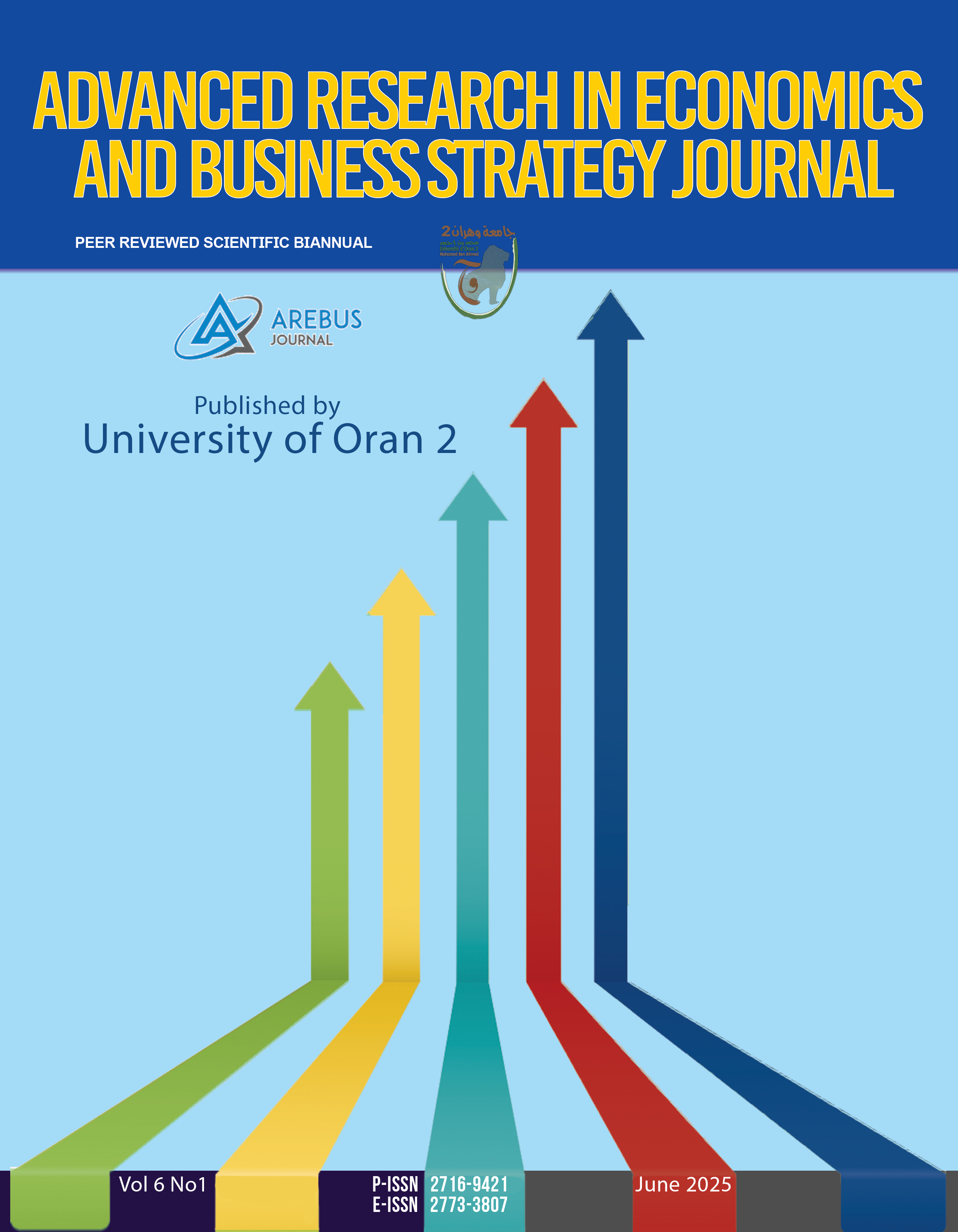Assessing the Implication of Physical Well-Being on Job Satisfaction and Performance of Employees in Selected Hotels in Akure, Ondo State, Nigeria
Abstract
Physical well-being is frequently neglected, yet it is an undeniably significant aspect of overall wellness. Indeed, no single aspect of wellness operates in isolation; hence, emotional, physical, and social well-being are all interrelated. This study, therefore, assesses the implication of physical well-being on the satisfaction and performance of employees in selected hotels in Akure, Ondo State, Nigeria. This study employs a quantitative research method, distributing an online questionnaire via Google Forms. Convenience sampling method was employed to choose four (4) hotels in Akure that are regarded as part of the top 20 hotels in the city with the total of 120 respondents selected across the hotels. The regression analysis results indicate that physical well-being (R2 = 0.577; t= 12.696; p= 0.000) accounts for 57.7% of the total variance, demonstrating a strong relationship in determining job satisfaction. It was also found that physical wellbeing (R2 = 0.637; t= 14.397; p= 0.000) account for 63.7% of the total variance which is a high coefficient in the determination of employee performance. This study concluded that physical well-being has a positive significant influence on employee satisfaction and job performance. Therefore, it is recommended that organisations should provide extensive healthcare benefits to tackle their employees' health-related concerns. Organisations should implement wellness reimbursements and exercise subsidies for all employees as an integral component of their wellness program to enhance physical well-being.
Downloads
References
Abuhashesh, M., Al-Dmour, R. & Masa’deh, R. (2019). Factors that Affect Employees' Job Satisfaction and Performance to Increase Customers' Satisfactions. Journal of Human Resources Management Research, 23. DOI: 10.5171/2019.354277.
Addison, A. K. & Yankyera, G. (2015). An Investigation into How Female Teachers Manage Stress and Teacher Burnout: A Case Study of West Akim Municipality of Ghana. Journal of Education and Practice, 6(10), 1–24.
Adedipe, C. O. & Adeleke, B.O (2016). Human capital development in the Nigerian hospitality industry. Worldwide Hospitality and Tourism Themes, 8(2), 195–206. doi: https://doi.org/10.1108/whatt-11-2015-0051.
Adeola, O. & Ezenwafor, K. (2016). The hospitality business in Nigeria: issues, challenges and opportunities. Worldwide Hospitality and Tourism Themes, 8(2), 182-194. https://doi.org/10.1108/WHATT-11-2015-0053
Agrawal, A. (2019). The Motivational Formulation of Employee Happiness, Job Involvement, Workplace Climate, and its Impact on Organisational Performance. International Journal of Research in Social Sciences, 9(8), 313–323.
Akhbar, M.N, Harding, D., & Yanuarti, N. (2020). The Role of Wellbeing in the Workplace on Readiness to Change. Psychology: Journal of Psychological Thought and Research, 25 (2), 229–244. https://doi.org/10.20885/psikologika.vol25.iss2.art5
Akpan, E. E. & Eno, N. A. (2021). The role of ambience on customers’ patronage in the hotel industry (a case study of two hotels in Victoria Island, Lagos). Universal Academic Journal of Education, Science and Technology, 4(3), 80-89
Arena, R., Guazzi, M., Briggs, P. D., Cahalin, L. P., Myers, J., Kaminsky, L. A., Forman, D. E., Gerson Cipriano, J., Borghi-Silva, A., Babu, A. S., & Lavie, C. J. (2013). Promoting Health and Wellness in the Workplace: A Unique Opportunity to Establish Primary and Extended Secondary Cardiovascular Risk Reduction Programs. Mayo Clinic Proceedings, 88(6), 605. https://doi.org/10.1016/j.mayocp.2013.03.002
Arnold, K.A. (2017). Transformational leadership and employee psychological well-being: A review and directions for future research. Journal of Occupational Health Psychology, 22(3), 381.
Aziri, B. (2011). Job satisfaction: a literature review. Management Research and Practice, 3(4), 77–86.
Bakar, R.A., Hashim, R.C., Jayasingam, S., Omar, S. & Mustamil, N.M. (2018). Employee Well-being: A Matter of Choice. In A Meaningful Life at Work. Emerald Publishing Limited.
Bang, H., (2015). Volunteer age, job satisfaction and intent to stay: A case of non-profit sport organisations. Leadership and Organization Development Journal, 36(2), 161–176.
Basias, N. & Pollalis, Y. (2018). Quantitative and qualitative research in business & technology: Justifying a suitable research methodology. Review of Integrative Business and Economics Research, 7, 91-105.
Berry, L., Mirabito, A., & Baun, W. (2020). What’s the Hard Return on Employee Wellness Programs? Harvard Business Review; Harvard Business Review. https://hbr.org/2010/12/whats-the-hard-return-on-employee-wellness-programs
Bin Shmailan, A.S. (2016). The relationship between job satisfaction, job performance and employee engagement: An explorative study. Issues in Business Management and Economics, 4(1), 1-8. DOI:10.15739/IBME.16.001.
Bowling, N. A. (2018). The social psychology of employee well-being: A needs-based perspective. In J. E. Maddux (Ed.), Subjective well-being and life satisfaction (pp. 272–289). New York: Routledge.
Bowling, N.A., Eschleman, K.J. & Wang, Q. (2010). A meta-analytic examination of the relationship between job satisfaction and subjective well-being. Journal of Occupation and Organisational Psychology, 83, 915–934. doi: 10.1348/096317909X478557
Capio, C.M., Sit, C.H.P. & Abernethy, B. (2014). Physical Well-Being. In: Michalos, A.C. (eds) Encyclopedia of Quality of Life and Well-Being Research. Springer, Dordrecht. https://doi.org/10.1007/978-94-007-0753-5_2166
Chaudhuri, K., Reilly, K. & Spencer, D. A. (2015). Job satisfaction, age and tenure: A generalised dynamic random effects model. Economics Letters, 130, 13–16.
Chegini, M. G. (2010). The relationship between organisational culture and staff productivity public organisations Journal of Social Sciences, 6(1), 127–129.
Cho, H. (2023). Work-Leisure Conflict and Well-Being: The Role of Leisure Nostalgia. Leisure Sciences, 45(4), 309–330.
CIPD (2022). Wellbeing at work. CIPD. https://www.cipd.co.uk/knowledge/culture/well-being/factsheet#gref
Clark, F., Jackson, J., Carlson, M., Chou, C. P., Cherry, B. J. & Jordan-Marsh, M. (2011). Effectiveness of a lifestyle intervention in promoting the well-being of independently living older people: Results of the Well Elderly 2 Randomised Controlled Trial. Journal of Epidemiology and Community Health. doi: jech.2009.099754.
Cotton, P. & Hart, P.M. (2003). Occupational wellbeing and performance: a review of organisational health research. Australian Psychologist, 38(2), 118–127.
Creswell, J.W. (2018). Research Design: Qualitative, Quantitative & Mixed Methods Approaches. Qualitative, Quantitative and Mixed Methods Approaches. (5th ed.). Los Angeles, California: Sage.
Davies, R., Mcnabb, R. & Whitfield, K. (2015). Do high-performance work practices exacerbate or mitigate the gender pay gap? Cambridge Journal of Economics, 39, 537–564.
Davis, T., (2019). What is Well-Being? Definition, Type and Well-Being Skills. Psychology Today. [online]. Available from: https://www.psychologytoday.com/us/blog/click-here-happiness/201901/what-is-well-being-definition-types-and-well-being-skills [Accessed 12 January 2025].
De Witte, H., Pienaar, J. & De Cuyper, N. (2016). Review of 30 years of longitudinal studies on the association between job insecurity and health and well-being: Is there causal evidence? Australian Psychologist, 51, 18–31. doi:10.1111/ap.12176
Donaldson, S. I., Heshmati, S., Lee, J. Y. & Donaldson, S. I. (2021). Examining the building blocks of well-being beyond PERMA and self-report bias. The Journal of Positive Psychology, 16(6), 811–818.
Donaldson, S. I., van Zyl, L. E. & Donaldson, S.I. (2022). PERMA+ 4: A framework for work-related wellbeing, performance, and positive organisational psychology 2.0. Frontiers in Psychology, 12, 6261. E.
Downes, M., Thomas, A.S. & Singley. R.B. (2002). Predicting Expatriate Job Satisfaction: The Role of Firm Internationalization. Career Development International, 7, 24–36.
Edgar, F., Geare, A., Halhjem, M., Reese, K. & Thoresen, C. (2015). Well-being and performance: Measurement issues for HRM research. The International Journal of Human Resource Management, 26, 1983–1994. doi:10.1080/09585192.2015.1041760.
Fridayanti, F., Kardinah, N., & Fitri, T.J.N. (2019). The Role of Workplace Well-being on Mental Health: A Study on Employees with Disabilities. Psympathic: Scientific Journal of Psychology, 6(2), 191–200. https://doi.org/10.15575/psy.v6i2.5754
Gallagher, M.W., Lopez, S.J. & Preacher, K.J. (2009). The Hierarchical Structure of Well-Being. J. Pers., 77, 1025–1050.
Gallup, I. (2022). Help employees improve well-being and performance - Gallup. Gallup.com. https://www.gallup.com/workplace/215924/well-being.aspx
Global Wellness Institute. (2018). Home - Global Wellness Institute. Global Wellness Institute. https://globalwellnessinstitute.org
Gubler, T., Larkin, I. & Pierce, L. (2018). Doing Well by Making Well: The Impact of Corporate Wellness Programs on Employee Productivity. SSRN Electronic Journal, 64(11). https://doi.org/10.2139/ssrn.2811785
Guest, D. E. (2017). Human resource management and employee well-being: Towards a new analytic framework. Human Resource Management Journal, 27, 22–38. doi:10.1111/1748-8583.12139
Herwanto, H. & Ummi, F.T. (2017). The Effect of Well-Being Workplace on Elementary Teacher Performance. JPPP - Journal of Psychological Research and Measurement, 6(1), 55–60. https://doi.org/10.21009/JPPP.061.07
Hotels.ng (2024). Groovy Hotel Akure | Hotel in Akure | Hotels.ng. [online] Groovy Hotel Akure | Hotel in Akure | Hotels.ng. Available at: https://hotels.ng/hotel/1242682-groovy-hotel [Accessed 18 February 2025].
Hotels.ng (2024). Hotels in Akure | Ondo. [online] Hotels.ng. Available at: https://hotels.ng/hotels-in-ondo/akure [Accessed 18 February 2025].
Hotels.ng (2024). St Jacobs Hotel | Hotel in Akure | Hotels.ng. [online] St Jacobs Hotel | Hotel in Akure | Hotels.ng. Available at: https://hotels.ng/hotel/1438101-st-jacobs-hotel [Accessed 18 February 2025].
HSE (2022). Statistics - Costs to Britain of Workplace Injuries and New Cases of Work-related Ill Health. [online] Hse.gov.uk. Available at: https://www.hse.gov.uk/statistics/cost.htm.
Hudin, A.M. & Budiani, M.S. (2021). The relationship between Workplace Well-Being and Employee Performance at PT. X in Sidoarjo. 8(4). https://ejournal.unesa.ac.id
Huppert, F. A. (2009). Psychological well-being: Evidence regarding its causes and consequences. Applied Psychology: Health and Well-being, 1, 137–164. doi:10.1111/j.1758-0854.2009.01008.x
Hussain, A., Apostu, S.A., Kijkasiwat, P. & Vasa, L. (2022). A Cross-Country Study on the Determinants of Working Capital Management: Gmm Approach. Transformations in Business & Economics, 21, 288–305.
Investors in People. (2017). Improving performance with workplace well-being. Investors in People e-book. [online]. Available from: https://www.investorsinpeople.com/resources/ideas-and-inspiration/improving-performanceworkplace-wellbeing [Accessed 22 January 2025].
Ireri, K. (2016). High job satisfaction despite low income: A national study of Kenyan journalists. Journalism & Mass Communication Quarterly, 93(1), 164–186. doi: 10.1177/1077699015607334
Kern, M., Waters, L., Adler, A. & White, M. (2014). Assessing Employee Wellbeing in Schools Using a Multifaceted Approach: Associations with Physical Health, Life Satisfaction, and Professional Thriving. Psychology, 5, 500–513. doi: 10.4236/psych.2014.56060.
Khaleel, M. & Chelliah, S. (2018). Employee Wellbeing English Language Proficiency a Key to Knowledge Sharing and Social Interaction. In Social Media for Knowledge Management Applications in Modern Organisations, 237–262.
Kim, C.Y. (2021). Psychological Well-Being, Knowledge Management Behavior and Performance: The Moderating Role of Leader-Member Exchange, Frontiers in Psychology, 12, 1–10. doi: 10.3389/fpsyg.2021.566516.
Koopmans, L., Bernaards, C., Hildebrandt, V., Schaufeli, W., De Vet Henrica, C. & Van Der Beek, A. (2011). Conceptual frameworks of individual work performance: A systematic review. J. Occup. Environ. Med., 53, 856–866.
Kotter, J. P. & Heskett, J. L. (2011). Corporate culture and performance. New York: Free Press.
Lee, Y. (2019). JD-R model on psychological wellbeing and the moderating effect of job discrimination in the model: findings from the MIDUS. European Journal of Training and Development, 43(3/4), 232–249.
Locke, E. (1976). E-nature and causes of job satisfaction, in Handbook of Industrial and Organizational Psychology, M. D. Dunnette, Ed., pp. 1297–1349, Rand McNally, Chicago, IL: USA.
Miah, M.M. (2018). The impact of employee job satisfaction toward organisational performance: A study of private sector employees in Kuching, East Malaysia. International Journal of Scientific and Research Publications (IJSRP), 8(12). https://doi.org/10.29322/IJSRP.8.12.2018.p8437
Myo, Y., Khalifa, G. & Aye, T. (2019). The Impact of Service Quality on Customer Loyalty of Myanmar Hospitality Industry: The Mediating Role of Customer Satisfaction. International Journal of Management and Human Science, 3(3), 1–11.
Nabawi, R. (2020). The Effect of Work Environment, Job Satisfaction and Workload on Employee Performance. Maneggio: Scientific Journal of Master of Management, 2(2), 170–183.
Neumeier, L.M., Brook, L., Ditchburn, G. & Sckopke, P. (2017). Delivering your daily dose of well-being to the workplace: A randomised controlled trial of an online well-being programme for employees. European Journal of Work and Organisational Psychology, 26(4), 555–573.
Nielsen, K., Nielsen, M.B., Ogbonnaya, C., Känsälä, M., Saari, E. & Isaksson, K. (2017). Workplace resources to improve both employee well-being and performance: a systematic review and meta-analysis. Work Stress, 31, 101–120. doi: 10.1080/02678373.2017.1304463.
Oliveira-Silva, L. C., & Porto, J. B. (2021). Subjective well-being and flourishing at work: The impact of professional fulfilment. Revista de Administração Mackenzie, 22(1), 1–24. doi:10.1590/1678-6971/eRAMG210117
Owoyemi O. O. & Ekwoaba J. O. (2014). Organisational culture: A tool for management to control, motivate and enhance employees’ performance. American Journal of Business and Management, 3(3), 168-177.
Parks, K. & Steelman, L. (2008). Organisational Wellness: A Meta-Analysis. Journal of Occupational Health Psychology, 13(1), 58-68.
Paul, E. M. & Phua, S. K. (2011). Lecturers job satisfaction in a public tertiary institution in Singapore: Ambivalent and non-ambivalent relationships between job satisfaction and demographic variables. Journal of Higher Education Policy and Management, 33(2), 141–151.
Peccei, R., Van De Voorde, K. & Van Veldhoven, M. (2015). HRM, Well-being and Performance: A theoretical and empirical review. In Well-Being and Performance at Work. The Role of Context; Psychology Press: London, UK; New York, NY, USA, 15–45.
Penedo, F.J. & Dahn, J. R. (2005). Exercise and wellbeing: A review of mental and physical health benefits associated with physical activity. Current Opinion in Psychiatry, 18(2), 189–193.
Psico-smart.com. (2023). Strategies for Enhancing Employee WellBeing and Its Correlation with Job Satisfaction. Psico-Smart.com. https://psico-smart.com/en/blogs/blog-strategies-for-enhancing-employee-wellbeing-and-its-correlation-with-job-satisfaction-169467
Rahmani, K., Gnoth, J. & Mather, D. (2018). Hedonic and eudaimonic well-being: a psycholinguistic view. Tourism Management, 69, 155–166.
Rasool, S. F., Wang, M., Tang, M., Saeed, A. & Iqbal, J. (2021). How Toxic Workplace Environment Effects Employee Engagement: The Mediating Role of Organisational Support and Employee Wellbeing. International Journal of Environmental Research and Public Health, 18(5), 2294. MDPI AG. Retrieved from http://dx.doi.org/10.3390/ijerph18052294
Ravalier, J.M., Wegrzynek, P. & Lawton, S. (2016). Systematic review: Complementary therapies and employee well-being. Occupational Medicine, 66(6), 428-436.
Ryan, R. M. & Deci, E. L. (2001). On happiness and human potentials: A review of research on hedonic and eudaimonic well-being. Annual Review of Psychology, 52, 141–166. doi: 10.1146/annurev.psych.52.1.141.
Ryff, C.D. (2018). Eudaimonic well-being: highlights from 25 years of inquiry, in Shigemasu, K., Kuwano, S., Sato, T. and Matsuzawa, T. (Eds), Diversity in Harmony– Insights from Psychology: Proceedings of the 31st International Congress of Psychology, John Wiley & Sons, pp. 375–395.
Sale, J.E. & Thielke, S. (2018). Qualitative research is a fundamental scientific process. Journal of Clinical Epidemiology, 102, 129-133.
Salgado, J.F., Blanco, S. & Moscoso, S. (2019). Subjective well-being and job performance: Testing of a suppressor effect. Revista de Psicología Del Trabajo y de Las Organizaciones, 35(2), 93-102.
Santos, R.S. & Lousã, E.P. (2022). Give Me Five: The Most Important Social Values for Well-Being at Work. Administrative Sciences 12, 101.
Shin, D. & Konrad, A.M. (2017). Causality between high-performance work systems and organisational performance. Journal of Management, 43(4), 973–997.
Soebbing, B.P., Wicker, P. & Weimar, D. (2015). The impact of leadership changes on expectations of organisational performance. Journal of Sport Management, 29(5), 485-497.
Spector, P. E. (1997). Job satisfaction: Application, assessment, causes, and consequences. Thousand Oaks: CA: Sage.
Spencer, E. S., Deal, A. M., Pruthi, N. R., Gonzalez, C. M., Kirby, E. W. & Langston, J. (2016). Gender differences in compensation, job satisfaction and other practice patterns in Urology. The Journal of Urology, 5(1), 450–455.
Sprigg, C.A., Niven, K., Dawson, J., Farley, S. & Armitage, C.J. (2019). Witnessing workplace bullying and employee well-being: A two-wave field study. Journal of Occupational Health Psychology, 24(2), 286.
Stephen, E.N. & Stephen, E.A. (2016). Organisational Culture and Its Impact on Employee Performance and Job Satisfaction: A Case Study of Niger Delta University, Amassoma. Higher Education of Social Science, 11(5), 36–45.
Suárez-Albanchez, J., Jimenez-Estevez, P., Juan Jose Blazquez-Resino & Santiago Gutierrez-Broncano. (2022). Team Autonomy and Organizational Support, Well-Being, and Work Engagement in the Spain Computer Consultancy Industry: The Mediating Effect of Emotional Intelligence. Administrative Sciences, 12, 85.
Tina H. P. K. & Loretto, W. (2017). Well-being and HRM in the changing workplace. The International Journal of Human Resource Management, 28(16), 2229-2255, DOI: 10.1080/09585192.2017.1345205
United Nations (2025). Goal 3: Ensure healthy lives and promote well-being for all at all ages. [online] United Nations Sustainable Development Goals. Available at: https://www.un.org/sustainabledevelopment/health/.
Weiss, H.M. (2002). Deconstructing job satisfaction separating evaluations, beliefs and affective experiences. Human Resource Management Review, 12, 173–194. doi: 10.1016/S1053-4822(02)00045-1
World Health Organization, (2016). Stress at the workplace. [online]. Available from: http://www.who.int/occupational_health/topics/stressatwp/en/ [Accessed 16 January 2025].
Wrzesniewski, A., Dutton, J.E. & Debebe. G. (2003). Interpersonal Sense-Making and the Meaning of Work. Research in Organisational Behavior, 25, 93–135.
Zheng, X., Zhu, W., Zhao, H. & Zhang, C.H.I. (2015). Employee well-being in organisations: theoretical model, scale development, and cross-cultural validation. Journal of Organisation Behaviour, 36, 621–644. doi: 10.1002/job.1990

This work is licensed under a Creative Commons Attribution 4.0 International License.

















